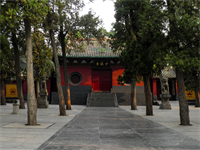Shaolin Temple and Zen (Chan)

Kung-fu action movie fans are familiar with the Shaolin Temple (少林寺) at Mount Shaoshi (少寶山) in the county of Dengfeng, Henan province (河南鄧封). They know all the Shaolin monks are kung-fu experts, but not too many of them are aware the temple is where the first Zen or Chan (禪) patriarch founded the now world-renowned Buddhist school. Shaolin does not mean "A Little Forest,” of course. The temple got its name because it is amidst the forest of "lin” (林) at Shaoshi. Only "Shao” is adopted, while "shi” or "Room” is dropped.
Chan or Zen is what is known as the intuitive school. Chan is a transliteration of the Sanskrit word dhyana, the last segment of the Eightfold Right Path (八正道) in Buddhism. When it was introduced to Japan, the Japanese called it Zen, for thus the Chinese character was produced there. Daisetsu Suzuki (鈴木大拙) of Japan introduced it to the West in the early twentieth century; and as a result, Zen is used in Western literature about the intuitive school, founded by Bodhidharma (普提達摩), who is known in Japan as Daruma-taishi (達摩大師). Daruma is the Japanese transliteration of Dharma (which actually means the Law or Buddhism in this case), with "taishi” meaning "Great Teacher” or "Great Master” or simply "Master.” Incidentally, a very popular toy in Japan is Daruma, a tumbler which has no hands and legs. Legend has it that Bodhidharma lost all four limbs after facing the wall in constant meditation for nine — some people say eight or ten — years at the Shaolin Temple in Henan.
The goal of the intuitive school is immediate insight, enlightenment such as Gautama Siddhartha achieved under the Bo-tree. The method of salvation is nominally dhyana or meditation, but salvation is actually obtained not by meditation but by insight or awakening (prajna) following on meditation. To some who are of this way of thinking scholarly research, the reading of books, listening to lectures, doing good works, the performance of rituals, and so on are not only of little merit in themselves but often a hindrance to true insight into the Buddha-reality. One must find salvation by looking inward into one’s own nature.
Generally, Zen sects have accepted as normative four conditions: 1) A special oral transmission from master to disciple outside the scriptures; 2) no dependence upon the authority of words and letters; 3) direct pointing to the soul of man; and 4) seeing into one’s own nature and attaining Buddhahood.
Bodhidharma is believed to be an Indian scholar or guru. No more than a legendary figure, he may have come to China at the end of the fifth century at the time when the growing influence of Buddhism had claimed an imperial convert, the Emperor Wu Di of the Southern Liang Dynasty (後梁武帝502-550).